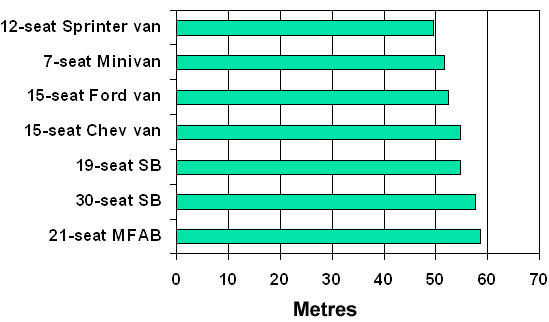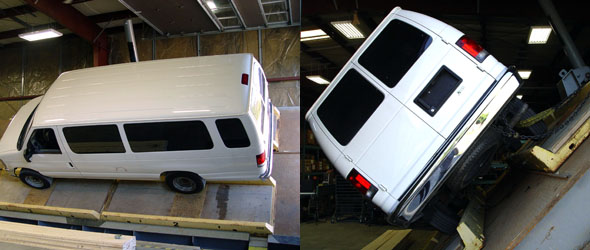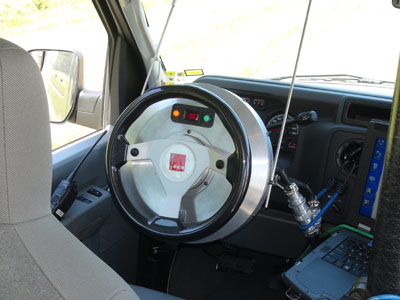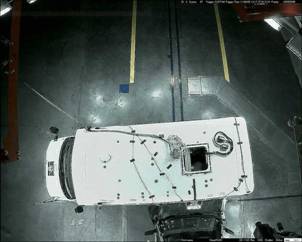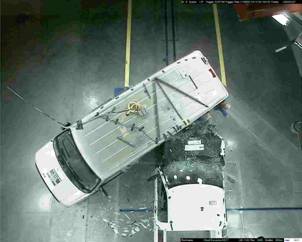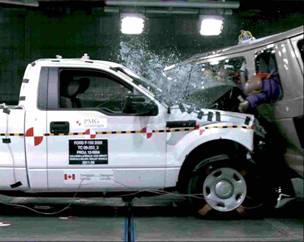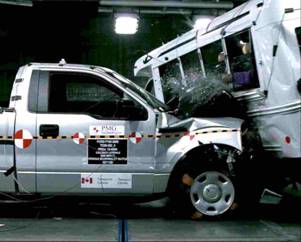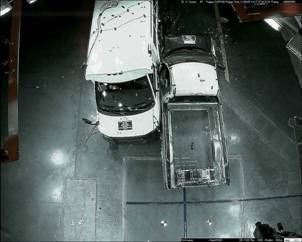United States
In 2001, the United States Department of Transportation, National Highway Traffic Safety Administration (NHTSA) issued a warning that 15-passenger vans had a higher chance of rolling over when they were fully loaded. In 2008, NHTSA issued a research note stating that deaths in large passenger vans have been declining since 2001, but did not explain this trend. Learn more at: www-nrd.nhtsa.dot.gov/Pubs/810947.PDF
Canada
In 2001, Transport Canada reviewed the Ontario collision data for 1997 and 1998 to verify whether the increase in the risk of a rollover in 15-passenger vans, as identified by NHTSA, could be detected. In those two years, we found only one rollover collision with 10 or more occupants; no occupant was killed in that rollover. This incident was not enough to issue a warning similar to the United States at the time.
Transport Canada also conducts many on-the-scene collision investigations every year. They help determine if Canadian vehicle safety standards require change.
Recent Investigations
On January 12, 2008, a 15-passenger van (1997 Ford E350 XL Super Club Wagon) carrying a high school basketball team from Bathurst New Brunswick collided with a transport truck on a highway near Bathurst, resulting in eight fatalities.
Transport Canada investigated the Bathurst collision in collaboration with the RCMP. The report concluded that there were three major contributing factors: poor weather, driver error and poor mechanical condition of the van. There were multiple mechanical issues, but the most critical was that the van was equipped with misaligned, worn and improperly inflated all-season tires unsuited for winter driving. It also concluded that the 15-passenger van involved was certified to meet all applicable Canadian Motor Vehicle Safety Standards for its class when it was built; its basic design was not identified as a contributing factor in the collision.
In June 2010, Transport Canada announced that it would review the safety of vans used for student transportation. This review was to include consultations with provincial and territorial governments, an assessment of the safety and stability of extracurricular activity vehicles, brake testing and testing to determine the vehicle rollover threshold.
Phase I Test Results
The first of three phases of the test program involved crash avoidance tests that were performed on 15-passenger vans as well as other vehicles perceived to be suitable alternatives for student transportation for extra-curricular activities. Seven vehicles were used in the tests: a 7-passenger minivan, a 12-passenger van, two 15-passenger vans, a 19-seat mini school bus, a 30-seat mini school bus, and a 21-seat Multi-Functional Activity Bus ( MFAB). Three metrics were evaluated: the emergency stopping distance from 100 km/h, the Static Stability Factor and the Static Rollover Threshold.
The stopping distance of a vehicle is an important part of vehicle performance and crash avoidance. The stopping distance was measured by driving the test vehicle at a speed slightly higher than 100 km/h, releasing the accelerator pedal and, once the vehicle speed reached 100 km/h, quickly applying the brakes; ten emergency stops were performed and the average stopping distance was computed. The emergency stopping distance was determined for both the unloaded and fully loaded conditions. The testing determined that emergency stopping distances from 100 km/h varied from 49.6 to 59.9 metres in the unloaded condition and from 49.6 to 58.5 metres in the loaded condition (see Figure 1).
Static Stability Factor (SSF) is a measure of the rollover resistance of a vehicle; a vehicle with a high SSF will be more stable in roll than a vehicle with a lower SSF. SSF is a measure of how top-heavy a vehicle is. It is used to estimate the probability (Rollover Risk) that a vehicle will roll if tripped sideways in a single-vehicle crash, such as when a vehicle leaves the paved shoulder of the road. The relationship between the SSF and the Rollover Risk was determined by the US National Academy of Sciences and the US National Highway Traffic Safety Administration using US accident data .Footnote 1 The SSF is computed by dividing half of the vehicle track width by the height of its centre of gravity; the height of the centre of gravity is determined through a laboratory test procedure that involves lifting the front or the rear axle of the vehicle and measuring the change in load on the other axle. The SSF was computed only for the unloaded condition, since the Rollover Risk is computed only from the SSF of an unloaded vehicle. In our test, the SSF varied from 1.27 to 0.94; Figure 2 shows the SSF we obtained with the associated Rollover Risk and US Rollover Rating.
Figure 2. Static Stability Factor for Test Vehicles
| Vehicle | SSF | Rollover Risk | US Rollover Rating |
| 7-seat Minivan | 1.27 | 17% | |
| 15-seat Ford van | 1.08 | 33% | |
| 15-seat Chevrolet van | 1.06 | 36% | |
| 21-seat MFAB | 1.06 | 36% | |
| 30-seat School Bus | 0.99 | 52% | |
| 12-seat Sprinter van | 0.95 | 69% | |
| 19-seat School Bus | 0.94 | 74% |
The Static Rollover Threshold (SRT) is the basic measure of the rollover stability of a vehicle; it is computed from the results of a test where the vehicle is tilted sideways until it rolls over. The SRT provides a good predictor of the risk of rollover in a constant radius curve and constant speed situation such as a highway exit ramp. We determined the SRT for both the unloaded and fully loaded conditions. In our tests, the SRT varied from 1.06g to 0.85g in the unloaded condition and from 1.04g to 0.72g in the loaded condition (see Figure 3). The results of the tilt-table show that these vehicles do not easily roll in that situation (highway ramp) but would tend to slide or skid. So the lateral force required to roll these vehicles is high compared to the force that can be developed between the tires and pavement.
Figure 3. Static Rollover Threshold (SRT) for Fully Loaded Vehicles
| Vehicles | SSF | Roll Threshold (g) |
| 7-seat Minivan | 1.27 | 1.04 |
| 21-seat MFAB | 1.06 | 0.81 |
| 15-seat Chevrolet van | 1.06 | 0.80 |
| 12-seat Sprinter van | 0.95 | 0.80 |
| 15-seat Ford van | 1.08 | 0.78 |
| 30-seat School Bus | 0.99 | 0.77 |
| 19-seat School Bus | 0.94 | 0.72 |
The performance of 15-passenger vans in these tests was as good as, or somewhat better, than the performance of the MFAB and mini school buses.
These test results and preliminary information on the safety review were presented by Transport Canada to the Council of Ministers Responsible for Transportation and Highway Safety on 30 September 2010 in Halifax. At that meeting the Canadian Council of Motor Transport Administrators was tasked with the development of a national policy for the transportation of students to extracurricular activities.
Subsequent to the June 2010 announcement, Transport Canada committed to conducting two additional phases of the test program. Phase II involves examining the dynamic handling of 15-passenger vans and MFABs while Phase III concerns crashworthiness tests on these vehicles. These tests were performed in 2011; results are presented below.
Phase II Test Results
Dynamic maneuvers were performed during the Summer of 2011 to obtain additional information on the handling of large vans and MFABs. For these tests, two 15-passenger vans and one 13 passenger Multi-Functional Activity Bus ( MFAB) were used; both 15-passenger vans came equipped with Electronic Stability Control ( ESC) while the MFAB did not. Tests were performed in the nominal load and fully loaded conditions and, for vehicles equipped with ESC, with ESC active and deactivated. An “automated steering controller”Footnote 2, or steering robot (Figure 4), was used to execute the steering manoeuvres in a precise and repeatable manner. Outriggers (Figure 5) were used to provide a safer environment for the driver by preventing the test vehicle from rolling over.
A total of some 800 tests were performed; two of the dynamic manoeuvres used were:
- Sine with Dwell manoeuvre: The test simulates a sudden lane change to avoid crashing into an obstacle on the road; the manoeuvre is also used by Transport Canada to verify compliance with CMVSS 126. In this test, the driver accelerates the vehicle to a speed slightly higher than the test speed (80 and 100 km/h) and then releases the accelerator pedal. When the vehicle reaches the test speed, the driver activates the steering robot. These manoeuvres are repeated with increasing steering wheel angles until either the vehicle spins out or the maximum steering wheel angle for the vehicle is reached.
- Fishhook manoeuvre: The test approximates the steering that a driver, acting in panic, might use in an effort to regain lane position once the vehicle has strayed onto the shoulder of the road. This test is used by the US National Highway Traffic Safety Administration ( NHTSA) as part of their New Car Assessment Program for evaluating the rollover risk of a vehicle. This manoeuvre tries to make the vehicle roll over. In this test, the driver accelerates the vehicle to a speed slightly higher than the test speeds (55, 65, 70, 75 and 80 km/h) and then releases the accelerator pedal. When the vehicle reaches the test speed, the driver activates the steering robot. These manoeuvres are repeated with increasing test speeds until either the vehicle spins out, or two wheels lift off the pavement or the maximum test speed is reached. For tests performed in the fully loaded condition, vehicles were tested with the rear tires inflated to the manufacturer recommended pressure of 550 kPa (80 psi) and at a severely underinflated pressure of 340 kPa (50 psi).
High precision inertial and GPS instruments were used to measure the motion, position and orientation of the test vehicles during these manoeuvres. The data from these instruments were recorded by an on-board data acquisition system. In addition, and mostly for documentation purposes, the various tests were captured on video.Multimedia Help
The test results showed that ESC significantly improves the yaw stability (which means the ability to avoid spinning out sideways) of this type of vehicle (buses with a GVWR over 4000 kg). Vehicles with ESC ON could perform the Sine with Dwell manoeuvre at 80 and 100 km/h and in the nominal and full load condition without spinning out. It was not possible to complete the full test sequence mandated in CMVSS 126 when ESC was disabled on the Ford E-350 or Chevrolet Express, or with the Girardin Minibus which did not have ESC.
Video description
The video-clip shows four tests using the Sine with Dwell manoeuvre, all tests being performed at 80 km/h in the nominal load condition. The steering wheel angle for the MFAB (sequence #1) is 130°; the steering wheel angle for the next two sequences with the 15-passenger van is 167°, first with ESC active, then with ESC turned off. The steering wheel angle in the fourth sequence is 300° and ESC is active. As can be seen, the MFAB spun out while the 15-passenger van was stable when ESC was active, even when it was tested with a steering wheel angle of 300°.
ESC (and possibly Roll Stability Control in the case of the Ford vehicle) significantly improved the roll stability (which is the ability to avoid tipping or rolling over) of the Ford and Chevrolet 15-passenger vans since they were capable of completing the Fishhook manoeuvre at nominal and full load. These vehicles could even complete these manoeuvres when the tire inflation pressure of the rear axle tires was reduced from 550 kPa (80 psi) to 340 kPa (50 psi). With ESC off or not fitted, none of the vehicles could complete the Fishhook manoeuvres.
The first Fishhook manoeuvre with the Girardin minibus in the full load condition was performed at a speed of 55 km/h. The vehicle spun out and tipped so much that it would have rolled over if it had not been equipped with outriggers. When the inflation pressure for the rear tires was checked, it was noticed that it was only 340 kPa (50 psi) instead of the recommended 550 kPa (80 psi). The inflation pressure of the rear tires was adjusted to 550 kPa (80 psi) and the Fishhook manoeuvre was re-attempted at 55 km/h. Although the vehicle did spin out, it did not tip to the extent that it had in the previous test. The manoeuvre was repeated at a speed at 65 km/h and, this time, the vehicle spun out, tipped and would have rolled over if it had not been equipped with outriggers (see video clip). One can conclude that correct tire pressures are required to maximize the roll stability of large vans – see here for more information on tires and tire inflation pressure.
Video description
Description: The video-clip shows three tests using the Fishhook manoeuvre, all tests being performed at 65 km/h in the full load condition. In the first two sequences with the 15-passenger van, the steering wheel angle is 258°; ESC is active in the first sequence but was turned off in the second sequence. In the third sequence (with the MFAB), the steering wheel angle is 227°. As can be seen, the 15-passenger van performed the manoeuvre without spinning out or tipping over when ESC was active; with ESC turned off, the van spun around. On the other hand, the MFAB tipped so much that it would have rolled over if the vehicle had not been equipped with outriggers.The results of the dynamic tests performed in the Summer of 2011 can be summarized as follows:
| Vehicle | ESC Status | Yaw (directional) Stability | Roll Stability |
| Ford Econoline | ON | No tip or spin-out | No tip or spin-out |
| OFF | Tip or spin-out | Tip or spin-out | |
| Chevrolet Express | ON | No tip or spin-out | No tip or spin-out |
| OFF | Tip or spin-out | Tip or spin-out | |
| Girardin Minibus | N/A | Tip or spin-out | Tip or spin-out |
Where a green cell indicates that the test vehicle did not spin out or tip enough to cause the outriggers to touch the pavement. A red cell indicates that vehicle did spin out or tipped enough to cause the outriggers to touch the pavement. The benefit of ESC in improving the dynamic stability of large vans and buses is clearly evident. These results apply across different speeds, vehicle loads and tire pressures used in our test programme.
Phase III Test Results
The objective of the tests was to compare the protection available to restrained occupants of a 15-passenger van to that available to restrained occupants in an MFAB (Multi-Functional Activity Bus) in a severe side impact crash test. The severity of the tests, as determined by the size and impact speed of the bullet vehicle, was substantially greater than the severity of tests that are conducted for regulatory compliance and consumer safety rating side impact protection programs world-wide.
A model year 2011 MFAB and a model year 2011 Ford E350 15-passenger van were each impacted at 90 degrees in the left rear axle by a 2009 Ford F150 pick-up truck travelling at 75 km/h. The rear axles were selected as the location of impact to ensure that the striking bullet vehicle impacted structural elements that were common to both struck test vehicles.
The sequence of movement of the test and bullet vehicles as recorded by high speed video camera freeze frames are shown in Figure 6 (a) through (h). The two test vehicles rotated in a similar counter-clockwise manner as depicted in these paired photographs.
Figure 6 (a-h). Sequence of motion of the test and bullet vehicles recorded by high speed video cameras
Seven crash test dummies had been placed on board each vehicle in comparable seating locations as shown in Figures 7 and 8. The dummies were representative in size to mid size men and small women. All were instrumented with state-of-the-art sensors in the head, chest and pelvis. All were seated upright and all were restrained with the available lap-shoulder seat belt. The motions of the dummies during the crash were recorded with several high speed video cameras.
The injury measures obtained from the dummies that were seated on the struck side of the E350 were generally greater than for the same dummies seated in the MFAB. Two of the three dummy heads were ejected from the window of the E350 while only an arm of the dummy seated in the rearmost row of the MFAB broke through the window.
The distance between the struck side dummies and the sidewalls influenced the injury measures. The interior trim profile of the E350 created an irregular profile and gap which allowed the dummy to accelerate and pivot, prior to striking the adjacent window. In the MFAB, the dummies were resting against the flat profile of the sidewall immediately prior to the crash. The outward motions of the heads were stopped by the rigid frames centered across each window in the MFAB.
In a real collision, the positions of the occupants at the moment of impact depend on their initial posture and the vehicle manoeuvres that take place just prior to the impact. Any behaviour or vehicle motion that causes the occupants to distance themselves from the surface they will eventually collide with during the crash, increases their risk of injury by allowing them to accelerate prior to hitting the surface. Also, since the window frames in the MFAB are not protected with energy absorbing materials, the risk of injury to the head during a collision involving human occupants exists.
All of the dummies placed across the aisle from the impact point in both the E350 and the MFAB slipped out of the shoulder belts. In the E350, spacing between adjacent occupants was sufficiently constrained so that the far side dummies collided with the struck side dummies. In the MFAB the small female dummies either slid into the aisle or were catapulted into the aisle. The mid size male dummy in the MFAB crossed the aisle and collided with the struck side dummy. The dummy responses suggest that for human passengers exposed to these conditions there would be a risk of moderate to severe head injury and a risk of serious seat belt related injuries for all those seated on the far side of the impact, in both struck vehicles.
The results of the paired crash tests are comparable to side impact testing of other motor vehicles conducted by Transport Canada. As previously mentioned, the severity of the tests was substantially greater than the severity of tests that are conducted for regulatory compliance and consumer safety rating side impact protection programs. The effects on the dummy occupants were significant in both cases and so there will be no further testing at more severe conditions.
The testing conducted by Transport Canada represents very specific combinations of vehicle models, speed at time of impact, dummies used, seating configuration, etc. The results do not lend themselves to generalization on how the same vehicle models would behave under different testing conditions or how different vehicles (other models of 15 passenger vans, MFABs) would behave under the same (or different) testing conditions. Therefore, Transport Canada does not draw any general conclusions concerning the crashworthiness of 15 passenger vans nor the MFAB types of vehicles.
A known countermeasure that can reduce the risk of head injury for struck side occupants is inflatable curtain technology. The countermeasures to limit occupant ejection from the shoulder portion of the seat belt and prevent subsequent occupant to occupant contact in all types of passenger vehicles, are still under development by industry and other parties. Potential candidate measures may include improved designs of restraints and seats, and the introduction of in-board side airbags.
As part of its regulatory program, Transport Canada will continue to assess the applicability of countermeasures for the protection of occupants of light-duty vehicles in general, during side impact collisions. This will be undertaken in the context of the Canada-U.S. Regulatory Cooperation Council and the activities thereunder.
